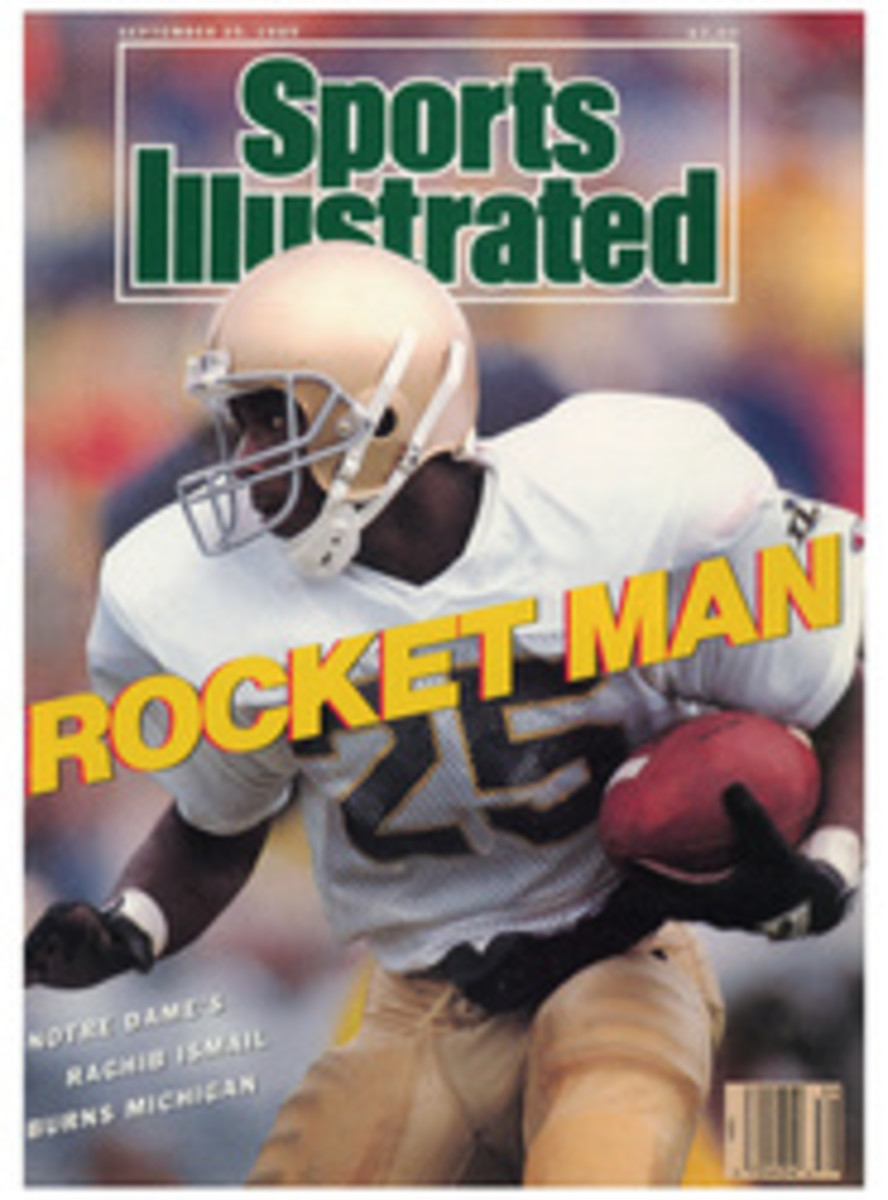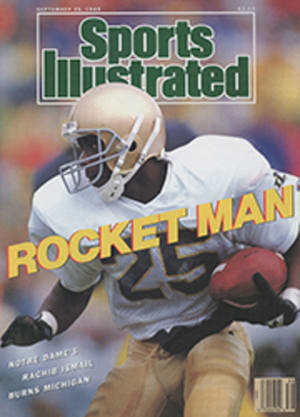
PUTTING FENWAY IN THE BACKYARD
Rick Ferroli, a 6'1" righthander, rears back on the mound, kicking his left leg high. In the cage, I wave my bat, tensing, as he uncoils and delivers. The ball leaves Ferroli's hand, and for the barest second I am able to follow it. Then it goes schizo. It has more movements than Beethoven. Up, down, right, left, right. By the time it curves over the heart of the plate, I'm dizzy. I listen to the umpire punch me out and realize that I have just been initiated into the world of serious Wiffle Ball.
"Did you see that?" I ask my teammate, Neill Norman, as he steps into the batter's box. The last time I played Wiffle Ball, Lyndon Johnson was President, Mickey Mantle was hitting home runs for the Yankees and the game with the plastic bat and ball was strictly for kids, a safe way for parents to introduce future major leaguers to the national pastime. I shout to Ferroli: "What was that?" The only time I had seen a pitch do such things was in a cartoon.
Ferroli shrugs, adjusts his black and gold Pirate hat, wipes the gold sweat-band on his brow and looks toward the plate. He once was a good enough pitcher to have been scouted by the White Sox, and when he was 23, he went to spring training with the Phillies. Now, at 33, his major league hopes are long gone. But a year ago, right here in the backyard of his mom's house in the Boston suburb of Hanover, Ferroli and his teammate, Rollie Belyea, won the World Wiffle Ball Association's 12th annual tournament over 23 other two-player teams from Massachusetts. This summer, in the WWBA's first-ever national tournament and with the teams expanded to three players each, Ferroli, his brother, Steve, and Belyea, finished second out of 32 teams from 20 states. They lost to their archrivals, Adam, Noel and Seth Frattasio, who were playing under the sponsorship of J. Murphy Sportswear, also of Hanover.
Last year, in an extended moment of chowderhead fever, Ferroli transformed his mom's backyard into a mini-Fenway Park, complete with mound, batting cage, outfield fences and, in left-field, a scale-model replica of the Wall. "When the Sox won the pennant in '67 my whole life changed," he says. "I was in seventh grade, and nothing else mattered to me. All I wanted to do was play in Fenway and send one over the Green Monster."
Twenty-one years later he constructed a 15-foot-high wall of plywood and secured it to the back of his mother's house. His mother, Patricia Duest, has thus far put up with the blotting out of daylight in her kitchen to give her son the chance to make his dream come true. Built into the right section of the Wall, which is painted green, is an electronic scoreboard made by Ferroli. A screened porch serves as both the scorer's booth and VIP box. The outfield distances are posted on the fences: Centerfield is 100 feet from the plate; down the line in right is 85 feet; and down the line in left, 66 feet. The infield corners are marked with orange traffic cones, and the pitcher's mound, 48 feet from home plate, slopes at a major league angle. Ten 300-watt lights illuminate night games. The waist-high centerfield and rightfield fences carry ads for MARSHFIELD FAMOUS PIZZA RTE. 139 OPEN TILL 2 AM and PHEASANT WOOD LANDSCAPING—PLANT DESIGN SPECIALISTS.
What began as a kid's fantasy embellished with props is threatening to become something larger. Ferroli has even written a Wiffle Ball rule book, modifying it from season to season to accommodate the changing nature of the game, with entries such as "A ball may be scuffed up between innings only" and "The umpire may ask for the opinion of spectators in making a call." Because there was so much interest in the games, Ferroli changed the rules this year to allow three people to play on each team.
The press has been alerted. USA Today, The Boston Globe, ESPN and The New York Times have all checked out the scene in Mrs. Duest's backyard. When Rick walked into a Boston bar last year, wearing the fancy jacket he awarded to members of the championship team (in this case himself and Belyea), he was collared by a big-name sports agent. "I've read about this," the agent told him, "and there's money to be made." Rick said, sure, go ahead, see what you can put together. "We're negotiating with several large corporations, but everything is still on the table," says Rick. "I can handle it if a big corporation wants to sponsor us. Absolutely, I can handle it." And it wouldn't bother him to put even more time into Wiffle Ball; he already devotes more time to it than to his contracting and commercial cleaning company.
In fact, the August 1988 championship had barely concluded when the media-wise and Wiffle Ball-hungry Ferroli decided to hold another tournament in October, with the proceeds going to the Jimmy Fund, a cancer charity supported by the Red Sox. The 16 two-man teams included Wiffle Bailers from New York, Vermont and Maine, as well as the neophyte duo of Norman and yours truly from Boston and New York City, respectively. As luck would have it, the draw matched us up against champs Ferroli and Belyea in the first round.
"We're just gonna be foolin' around here, right?" I say to Ferroli. He laughs. Undaunted, I assume my guise of reporter and ask him to show me the grips for the various pitches. I note a flicker of suspicion in his eyes as he weighs my request, but, fearing nothing, he tells me everything.
•Rising fastball. Thrown sidearm with the holes down, ring finger hooked around the seam that joins the halves of the ball together. Properly executed this pitch comes at you like a Frisbee that skims up off the pavement.
•Curveball. Thrown overhand with the holes to the right (for a righthander), index finger on the seam. No wrist snap required. Can break up to five feet.
•Screwball. Thrown overhand with the holes facing in, to the left on a righthander, index finger on the seam. This is the hardest pitch to throw, but when mastered it's a mind-boggier, more a corkscrewball than a screwball.
I study what I have written down. Unfortunately, I can't read the pitches to Ferroli and Belyea when I take the mound; I have to throw them. In the top of the first inning, that proves difficult. I walk each of them 12 or 13 times in the course of giving up 14 runs. But my wildness is contagious, and in the bottom of the inning Ferroli can't find the plate either. Norman and I rally for five runs on only one hit. (With only three balls constituting a walk, a large percentage of runs score on walks—too large to my way of thinking.)
In the top of the third inning, using a bat—half Louisville Slugger, half industrial plastic tubing—custom-made by Ted Williams's son, John Henry, a participant in the 1988 championship games, I whack a hanging Ferroli curve-ball off the "M" in the Marshfield sign, missing a grand slam by inches. Behind a fence, the next-door neighbors' kids cheer me from their perch on the roof of a shed.
Later on, sitting in the VIP box, I bask in the glow of our 39-16 drubbing. Ferroli, to my eyes at least, is still in shock from having given up 16 runs to a pair of beginners. He cues up The Star-Spangled Banner (he recorded it live at Fenway) and blasts it over the P.A. system. On the field, the players for the next game stand along the baselines, caps over their hearts, facing the flag that flies from atop the Wall.
As the game begins, a girlfriend of a member of the Maine Assorted Nuts team presents Ferroli with a cake decorated to look like the field. It has grass-green icing and a cardboard Wall complete with American flag. Pointing to a sugary white Wiffle Ball to one side of the infield, Ferroli says, "Look, the ball even has holes in it."
Dave Morrison, a Nut who works for L.L. Bean in Freeport, Maine, ducks in the screen door and gushes over the playing field. "To come to a park like this is like going to the World Series," he says. "My father used to say, 'Wiffle Ball will never take you anywhere.' But when I told him about this, he cried. Tears rolled down his cheeks."
"Let's face it," Ferroli says, "there aren't too many guys who would be willing or able to do this to their property. Sometimes I wonder if it's worth it. But then things'll happen like this cake. I mean, just take a look at it." He gestures toward the cake. "Just take a look at it, and then you tell me."
PHOTO
MANNY MILLAN
With the Wall behind him, Ferroli fires a Wiffle Ball.
Peter Alson, a New York City free-lance writer, plays softball in a Central Park league.

